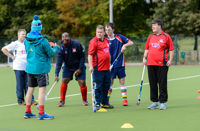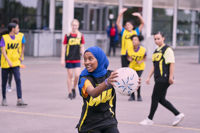
Safeguarding adults
Many sports and other organisations are not well enough informed to ensure that complaints and concerns about adults are properly identified and acted upon, which puts them at risk of failing to meet their duty of care.
It can be tempting for an organisation to prioritise child safeguarding and merely adapt existing child safeguarding policies for adults. Many sports and other organisations are not well enough informed to ensure that complaints and concerns about adults are properly identified and acted upon, which puts them at risk of failing to meet their duty of care. It also risks leaving the individuals concerned at best disillusioned with sports, and at worst vulnerable to harm.
Legal requirements
Legislation
The Ann Craft Trust provides a brief overview of relevant pieces of legislation and Government initiatives concerning safeguarding adults. This covers:
- Sexual Offences Act 2003
- Mental Capacity Act 2005
- Safeguarding Vulnerable Groups Act 2006
- Deprivation of Liberty Safeguards
- Disclosure & Barring Service 2013
- The Care Act 2014
- Making Safeguarding Personal Guide 2014
Definitions
Who might be considered an adult at risk?
It is important to recognise that safeguarding adults is both different, and in many ways more complex, than safeguarding children. It is not straightforward to identify an adult at risk because of the complexity around the Mental Capacity Act and the adult’s right to self-determination.
The Care Act 2014 defines an adult at risk as someone who:
- Has needs for care and support (whether or not the local authority is meeting any of those needs) and
- Is experiencing, or is at risk of, abuse or neglect, and
- As a result of those care and support needs is unable to protect themselves from either the risk of, or the experience of, abuse or neglect.
The Care Act also makes it clear that abuse of adults links to circumstances rather than the characteristics of the people experiencing the harm. Labelling groups of people as inherently ‘vulnerable’ is seen to be disempowering.
For some sports the number of adults ‘at risk’ for which there needs to be careful consideration may be small. Therefore we support the concept of welfare and respect for all adults. This is particularly important when we are thinking about inclusion, equality and diversity.
From a governance perspective, the tools to manage poor behaviours and abuse within a sport, and to manage concerns from outside the sport where they impact on another person’s welfare within the sport, are the same regardless of whether the ‘victim’ is considered an adult at risk or not.
Key definitions are discussed by the Ann Craft Trust.
The Care Act 2014 details ten different forms of abuse that an adult may be subject to:
- Self neglect - can be broadly defined as neglecting to care for one’s personal hygiene, health, or surroundings. An example of self-neglect could be hoarding.
- Modern Slavery - encompasses slavery, human trafficking, forced labour, and domestic servitude.
- Domestic Abuse - includes psychological, physical, sexual, financial, and emotional abuse perpetrated by anyone within a person’s family. It also includes so-called ‘honour’ based violence.
- Discriminatory – this is abuse that centres on a difference or perceived difference, particularly with respect to race, gender, disability, or any of the protected characteristics of the Equality Act.
- Organisational - includes neglect and poor care practice within an institution or specific care setting, such as a hospital or care home, or in relation to care provided in one’s own home. Organisational abuse can range from one-off incidents to ongoing ill-treatment. It can be through neglect or poor professional practice as a result of the structure, policies, processes and practices within an organisation.
- Physical - includes hitting, slapping, pushing, kicking, restraint, and misuse of medication.
- Sexual - includes rape, indecent exposure, sexual harassment, inappropriate looking or touching, sexual teasing or innuendo, sexual photography, subjection to pornography or witnessing sexual acts, indecent exposure and sexual assault, or sexual acts to which the adult has not consented, or was pressured into consenting.
- Financial or Material - includes theft, fraud, internet scamming, and coercion in relation to an adult’s financial affairs or arrangements, including in connection with wills, property, inheritance or financial transactions. It can also include the misuse or misappropriation of property, possessions, or benefits.
- Neglect and Acts of Omission - includes ignoring medical or physical care needs and failing to provide access to appropriate health social care or educational services. It also includes the withdrawing of the necessities of life, including medication, adequate nutrition, and heating.
- Emotional or Psychological - includes threats of harm or abandonment, deprivation of contact, humiliation, blaming, controlling, intimidation, coercion, harassment, verbal abuse, isolation, or withdrawal from services or supportive networks.
There are four additional types of harm that are not included in The Care Act, but they are also relevant to safeguarding adults.
- Cyber Bullying occurs when someone repeatedly makes fun of another person online, or repeatedly picks on another person through emails or text messages. It can also involve using online forums with the intention of harming, damaging, humiliating, or isolating another person. It includes various different types of bullying, including racist bullying, homophobic bullying, or bullying related to special education needs and disabilities. The main difference is that, instead of the perpetrator carrying out the bullying face-to-face, they use technology as a means to do it.
- Forced Marriage is a term used to describe a marriage in which one or both of the parties are married without their consent or against their will. A forced marriage differs from an arranged marriage, in which both parties consent to the assistance of a third party in identifying a spouse. The Anti-Social Behaviour, Crime and Policing Act 2014 make it a criminal offence to force someone to marry.
- A ‘mate crime’ is when ‘vulnerable people are befriended by members of the community who go on to exploit and take advantage of them’ (Safety Network Project, ARC). It may not be an illegal act, but it still has a negative effect on the individual. A mate crime is carried out by someone the adult knows, and it often happens in private. In recent years there have been a number of Serious Care Reviews relating to people with a learning disability who were seriously harmed, or even murdered, by people who purported to be their friend.
- Radicalisation aims to inspire new recruits, embed extreme views and persuade vulnerable individuals to the legitimacy of a cause. This may be direct through a relationship, or through social media.
The Ann Craft Trust provides further details on these types of harm.
Things to consider
Social Care Institute for Excellence has provided examples of indicators and things to look to be alert to covering each of these.
Principles of adult safeguarding
When we consider adult safeguarding, we must consider how we safeguard adults with them at the centre of decision-making.
Six principles set out by the Care Act underpin the safeguarding of adults:
- Empowerment
- Prevention
- Proportionality
- Protection
- Partnership
- Accountability
Making safeguarding personal
Rather than following a prescribed system, safeguarding for adults must take into account the individual choices and requirements of everyone involved.
The Ann Craft Trust provides further information on making safeguarding personal.
Mental Capacity Act
It is sometimes assumed that decisions must be made for an adult considered ‘at risk of abuse’ as they cannot make decisions themselves. The starting point has to be that an adult has the capacity to make a decision unless proven otherwise and that unwise decisions are not necessarily wrong ones. For more information, see the Ann Craft Trust’s guidance on capacity and decision-making.
